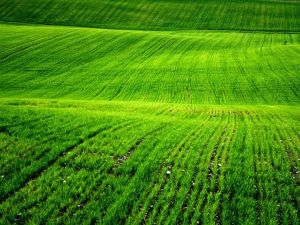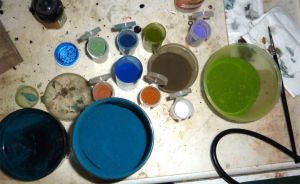Pigment (Green) Tool of the Painting (Chlorophyll)
Making pigment is often times a difficult task. In drying berries and other live things, it is important to slowly dry them to preserve the color. Grass makes for a brilliant green-yellow pigment and the reason for that is its Chlorophyll which is a magnificent component of plants in the way it interacts with light to create energy…the energy for life. The green color of Chlorophyll stains (like the Tide detergent commercial where kids have grass stains on their knees), and is very difficult, if not impossible to remove. This is a good thing for the making of pigment.
Due to the staining properties and my abode being rented, I opted the purchasing of concentrated Chlorophyll in an easy to disperse dropper bottle. I preferred the type not distilled by alcohol as that might effect the longevity or viability of the painting. After much research, I chose a product called Chloro-Oxygen. Remarkably enough this product can also be taken in water to provide healthy nutrients for the human body, just as plants! My personal goal is to drink a glass every time I use it to create pigment.
So, in order to capture the “pure” green and vibrant color of natural Chlorophyll, I drip one drop at a time into a small amount of clear acrylic polymer to produce light through dark green hues. The resulting color is more vibrant that the expensive Golden colors I mainly use for the painting. After I create the color, I slowly mix in a color, depending on what I want to achieve, such as a yellow or blue, or even white. It is very exciting to watch what is essentially a mystery unfold. There are times, of course where I am disappointed and those colors I turn into browns.
Chlorophyll (also chlorophyl) is a green pigment found in almost all plants, algae, and cyanobacteria. Its name is derived from the Greek words χλωρος, chloros (“green”) and φύλλον, phyllon (“leaf”). Chlorophyll is an extremely important biomolecule, critical in photosynthesis, which allows plants to obtain energy from light. Chlorophyll absorbs light most strongly in the blue portion of the electromagnetic spectrum, followed by the red portion. However, it is a poor absorber of green and near-green portions of the spectrum, hence the green color of chlorophyll-containing tissues. Chlorophyll was first isolated by Joseph Bienaimé Caventou and Pierre Joseph Pelletier in 1817.
Chlorophyll is vital for photosynthesis, which allows plants to obtain energy from light. Chlorophyll molecules are specifically arranged in and around photosystems that are embedded in the thylakoid membranes of chloroplasts. In these complexes, chlorophyll serves two primary functions. The function of the vast majority of chlorophyll (up to several hundred molecules per photosystem) is to absorb light and transfer that light energy by resonance energy transfer to a specific chlorophyll pair in the reaction center of the photosystems.
The two currently accepted photosystem units are Photosystem II and Photosystem I, which have their own distinct reaction center chlorophylls, named P680 and P700, respectively. These pigments are named after the wavelength (in nanometers) of their red-peak absorption maximum. The identity, function and spectral properties of the types of chlorophyll in each photosystem are distinct and determined by each other and the protein structure surrounding them. Once extracted from the protein into a solvent (such as acetone ormethanol), these chlorophyll pigments can be separated in a simple paper chromatography experiment and, based on the number of polar groups between chlorophyll a and chlorophyll b, will chemically separate out on the paper.
Chlorophyll is registered as a food additive (colorant), and its E number is E140. Chefs use chlorophyll to color a variety of foods and beverages green, such as pasta and absinthe. Chlorophyll is not soluble in water, and it is first mixed with a small quantity of vegetable oil to obtain the desired solution. Extracted liquid chlorophyll was considered to be unstable and always denatured until 1997, when Frank S. & Lisa Sagliano used freeze-drying of liquid chlorophyll at the University of Florida and stabilized it as a powder, preserving it for future use.














































